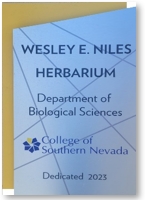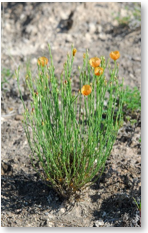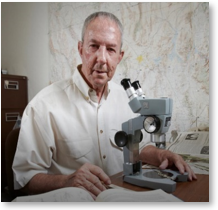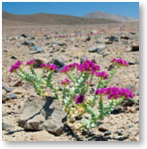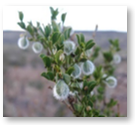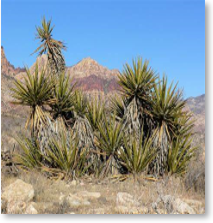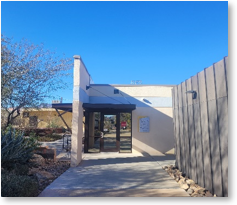Wesley E. Niles Herbarium
The Wesley E. Niles Herbarium is a collection of dried, pressed plant specimens mounted on archival quality sheets of paper, placed in folders, and stored in cabinets. The collection was relocated to the College of Southern Nevada Henderson Campus to continue to provide access to this invaluable resource to researchers, government agencies, and educators. Another mission of the collection is to inspire future generations of scientists to explore botany and climate change and how the two are interconnected.
Each sheet has a label affixed to it, providing the proper scientific name of the plant, the location and habitat where it was collected, the date of the collection, the collector’s name, and the collection number. The label information is also electronically recorded, so it is readily retrievable through a database. These specimens provide tangible documentation for the occurrence, distribution, and diversity of flowering plants, conifers, and mosses in the Southwestern desert regions of the United States, especially the Mojave Desert. The herbarium also serves as a center for research, teaching, and public service, and as a repository of potentially valuable genetic information.
History of the Wesley E. Niles Herbarium
The herbarium was originally founded in 1970 to assist biologists in their studies of the vegetation and flora of both Nevada and the Southwestern deserts. The collection was relocated from the University of Nevada Las Vegas to the College of Southern Nevada in January of 2023 to continue the work started by Dr. Wesley E. Niles. With CSN being the only college with such a collection located within this region of the Mojave Desert, collectors can center their activities largely within that geographical area, resulting in a collection that today is the best representation available of the Mojave Desert flora and surrounding deserts.
Collection
The herbarium collection consists of over 65,000 specimens of vascular plants, and a small but rapidly expanding number of mosses and liverworts. It is one of few herbaria in the country that
currently has its entire vascular plant collection accessible through a computerized database (Paradox). Allowing for more effective management and retrieval of collection information, the database is especially useful in addressing the geographical and ecological distribution of plant taxa, evaluating the status and conservation of rare species, and developing local and regional plant checklists and floras.National Resource Collection
In 1974, the Advisory Committee for the Systematic Resources in Botany (Systematic Botany Resources in America, Part I) surveyed 1,200 herbaria in the United States. Of these, 105 were designated as “National Resource Collections.” These collections are described as “of such importance for systematic study that their loss or inaccessibility would seriously impair our ability to carry on taxonomic research in the United States and the world.” The herbarium at CSN was the only herbarium within the state of Nevada and in the Mojave Desert to be so designated.
Loans from the herbarium
Loans of specimens are made to botanists at recognized scientific institutions for use in taxonomic/systematic studies. Requests for materials should be directed to the herbarium curators or collection manager. Loans are normally granted for a period of one year but may be extended when circumstances warrant.Destructive Sampling
As a rule, the removal of plant parts from the herbarium collections is not permitted without prior written consent from a curator. The use of herbarium specimens for extraction of DNA or other molecular compounds should be considered only when other sources of plant material, including live collections, are not available for study. The decision to allow for the destructive sampling of herbarium collections for scientific research rests with a curator who will consider written requests on a case-by-case basis. If permission is granted, adherence to the Herbarium Destructive Sampling Policy is required.
Exchanges with the herbarium
The herbarium participates in specimen exchange agreements with several institutions. Duplicate specimens, typically representative of the desert Southwest, may be available on a one-to-one basis to interested herbaria or research institutions. Visitors The herbarium is normally open from 9 a.m. to mid-afternoon, Monday-Thursday. Visitors are urged to contact the herbarium Manager (Dr. Marcus Hooker) to confirm that a staff member will be present to facilitate their visit. Email and requests for collection data retrieval can be addressed to Dr. Marcus Hooker.
Visitors to the facilities and contacts
The herbarium is located at the College of Southern Nevada, Henderson Campus, building A, Room 125. Automobile access is by way of 700 College Drive and Interstate 11. The herbarium is normally open 9 am to 3:00 pm, Monday-Thursday and Fridays by appointment only. Visitors are urged to contact the herbarium to confirm that a staff member will be present to facilitate their visit. Emails and requests for collection access and data retrieval can be addressed to either:Herbarium Manager
Dr. Marcus Hooker
Marcus.Hooker@csn.edu
WN-Herbarium@csn.edu
Herbarium Curator
Dr. Matthrew Mahrt
Matthew.Mahrt@csn.edu
WN-Herbarium@csn.edu
Administrative Support
Ms. Hermela Tsige
Hermela.Tsige@csn.edu
T: 702-651-3131
Notable Collectors
Included in the herbarium holdings are materials that are unique in historical and scientific interest to Nevada, the Mojave Desert, and the adjacent regions. These include the collections of:
- T. Ackerman (Desert National Wildlife Refuge)
- J.C. Beatley (Nevada Test Site)
- V. Bostick (Central and Southern Nevada)
- D. Charlet (Gymnosperms of the Great Basin)
- I.W. Clokey (Spring Mountains)
- M. Kurzius, D. Schramm, P. Peterson, and C. Annabel (Death Valley, California & Nevada)
- S. Meyer (Southern Utah)
- Pinzl, A. Tiehm, and H. Mozingo (Central and Northern Nevada)
- W. Niles, P. Leary, J. Holland, J. Alexander, and F. Landau (Nevada, California, Arizona)
- L. Stark (Mosses of the Southwestern deserts)
Map your visit to the Herbarium:
College of Southern Nevada
School of Science, Engineering, and Mathematics
Department of Biological Sciences
